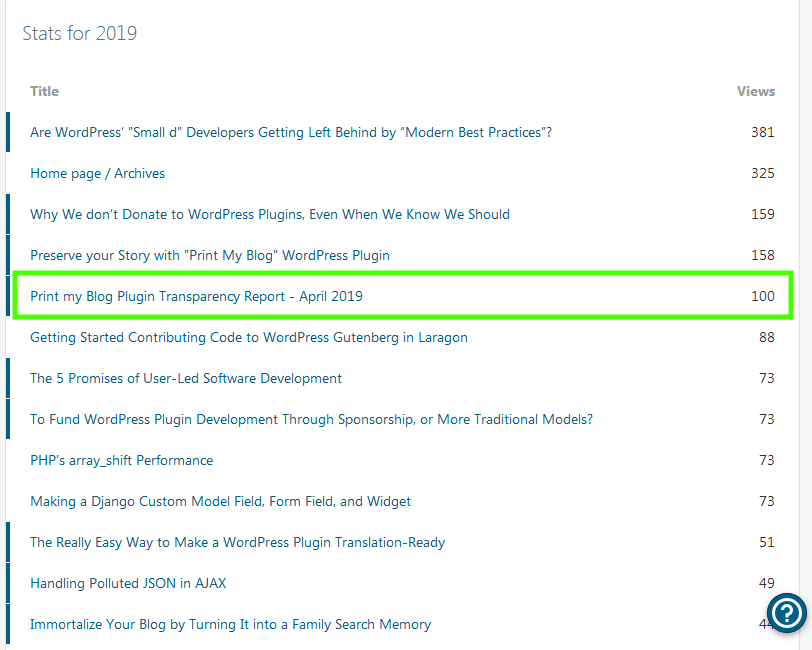Overview
This is my second monthly transparency report regarding development of Print My Blog WordPress plugin. For me, the most exciting developments this month has been hearing how folks are using Print My Blog. If you use it, please let me know on Twitter, through my contact page, or through a review on WordPress.org.
What Happened in May 2019


Overview of What’s New
- Added CSS classes for hiding content from printouts or web views, and a few other tweaks
- Private posts are now included in printouts
- Got on the WP Plugins A to Z podcast to talk about the plugin
- I got useful feedback from someone who printed a 10,000 post blog, the conversion rate of premium plugins (in case I decide to add that someday), and whole lot of NOT doing what I intended to last month…
- Total donations doubled (that is, increased from 1 to 2 😝)
The Details
New CSS Classes for Hiding Content
One of the main purposes of Print My Blog is to only print the content that makes sense for a printout– usually that’s the post’s body– while leaving out the superfluous stuff like sidebar widgets, menus, social media share buttons, etc. But sometimes plugins and themes add content to posts (like related posts, social media share buttons, advertisements, etc) that look like post content, but we’d really still prefer to leave out of printouts. Dealing with this content hasn’t been the greatest.
For content like that coming from other plugins or themes, it’s usually best to let me know in the support forums. Just say what plugin is generating what content, and the next release of Print My Blog will exclude it by default (for you and everyone else).
But if you have custom post content you’d rather be hidden, it helps to have a way to indicate “hide just this image from the printout” or “this paragraph is for the printout only, not when viewing online”. That’s what the new CSS classes are for.
If you’re using WordPress’ Gutenberg/Block editor, select a block, click “Advanced”, then “Additional CSS Class”, and add pmb-print-only if you want the block to only appear in the printout, or pmb-screen-only if you want the block to only appear on screen.
Here’s a video tutorial.
As usual, please let me know if you have any suggestions!
Private Posts Now Included in Printouts
User skrekkugle pointed out that private posts weren’t making it into their printouts. I was a little surprised because I recently did work to include password-protected posts, but overlooked private posts.
So, I changes a few lines of code, and skrekkugle tested it out, and then it was added in version 1.7.1. Please note: you need to be logged in and have access to read those private posts, otherwise they won’t appear in the printout.
(By the way, skrekkugle was kind enough to leave a review afterwards, so thanks skrekkugle for the feedback AND review.)
My Interview on WP Plugins A to Z
I got a message from my neighbouring WordPress meetup that it’s organizer, John Overall, was looking for plugin authors to interview for his podcast. It sounded like a good way to get the word out, and a growing experience for me.
You can find the interview here.
I got pretty tongue-tied initially, but I felt like we got some especially useful discussion going after the first 5 minutes.
I haven’t yet noticed a significant jump in users (probably because despite my best efforts to prepare, I don’t think I was a stellar interviewee). Still, it was a good experience for me being on my first podcast, got the plugin in front of some more people, and only took 40 minutes out of my day anyway. So John, if you’re reading this, thanks again for having me on your show!
Other Useful Feedback Gathered
I got a bit of useful feedback from various sources, which was both encouraging and interesting.
“John”’s Feedback on Filtering and Javascript-Dependent Content
User “John” left an encouraging 5-star review and feedback. He wanted a way to filter posts by date, the post’s meta information (date, categories, url, etc) to each appear on a separate line by default, and also had trouble with a plugin’s shortcode appearing in his printouts.
I found time to apply his suggestion to lay out post meta info on separate lines, and the other two are at the top of my priorities.
Someone Actually Printed 2 Million Words using this Plugin
Charles Buckman-Ellis wrote a post that was a treasure for me to read. He has a blog with over 10,000 posts, 2 million words, that he has actually printed in full from his home printer. (For reference: that’s over 4 times the length of the Lord of the Rings.)

That’s a lot! To my knowledge that’s the largest blog to use Print My Blog and biggest physical printout (the previous record had 3000 posts and they just created a PDF of it). You might think that’s a waste but most of us have a hundred times more paper books on our shelves. He plans to put them all into binders for easy-access, and use the physical copies for easier annotating (which is the other big application of Print My Blog).
He did report he had a problem though: his printer had a hiccup once it got halfway, and stopped printing. He could re-attempt printing, but Print My Blog would start at the beginning again 😖.
Most browsers let you specify a range of pages to print, and Charles worked around the issue by copying his entire blog’s content into Microsoft Word and manipulating it from there, so there are workarounds. But this is the third time filtering by post dates has been requested, so it’s definitely a priority.
Doubled Donations
Unfortunately I know nothing more about them: who they are, or why they donated. It would be great to know what motivated them, how they discovered Print My Blog and it’s open collective, and whether the receipts are of any value.
Thomas Knack donated $20 to forward Print My Blog., effectively doubling the total donations made so far.
But one piece of useful info: given they didn’t provide any contact info (just a name– open collective has their email), they probably didn’t do it for public recognition.
Thinking Out Loud
I didn’t make as much time to work on Print My Blog this month. My wife’s website got a redesign which used up most of my free time (and actually paid the bills). And I think that’s the reality with starting a project like this: until you’ve figured out that magic formula to make it popular and profitable, it’s very hard to keep putting time into it.
Anyways, here’s some reflections on the direction of Print My Blog.
Comparing To Bulma’s Donations
For my wife’s website’s redesign project, we used a CSS framework called Bulma. It’s 1000 times more popular than Print My Blog, and seems to be doing everything right in terms of seeking donations. So I tried to take some notes from what they’re doing.
Bulma is used by 150,000 developers, but has 70 backers
and $1327 in monthly income on Patreon. That’s about 0.05%, or a twentieth of a percent Of users who donate; so far Print My Blog has actually been fortunate to have 0.5%, or half a percent of users make a donation.
So that was a bit discouraging at the prospect of funding development entirely through donations.
What’s The Conversion Rate if Premium Plugins Anyway?
So I’ve been musing on having a premium version of the plugin, one that adds the features needed by publishers (or those who are at least generating revenue by using the software, as opposed to most of us who are just backing up memories.)
So, about 0.5% of Print My Blog users make a donation. So I wondered “How many more users pay of a free plugin choose to upgrade to a premium version?”
I asked that question on the Advanced WordPress Facebook Group.
Let’s say you have a free plugin or theme on WordPress.org, then create a premium version. What percentage of free users is likely to convert to using the premium version?
Somewhere between 99% – 10%? Or is 9% – 1% more reasonable? Or 0.9% – 0.01%?Looking for a ballpark and some reading.
Me, on the AWP Facebook Group
The most popular response was
You’re not going to find a trend here. There’s no magic percentage of customers that appears by launching a premium version. The transparency reports that do exist are from among the most successful plugins in the space and not indicative of the industry as a whole.
Here are the questions that, in my experience, determine the success of a freemium model:Are you delivering must-have value in the premium version? Did you give away too much in the free version so that users don’t feel the need to upgrade? Did you give away too little that they downloaded and abandoned the plugin right away? Is the upgrade path clear to users? Do they even know an upgrade path exists? Does your website convert once they get there? Are you supplementing traffic from the plugin with content marketing or paid advertising? Do you have a support team who has a clear track record of success on the support forums? Each of these questions can drastically affect conversion rates, and a misstep in one ore two of those areas such as overdelivering in the free version can make or break a premium product.
Kevin Hoffman from WordImpress
The next most popular response was
The market avg. is 0.5%-4.5%. The actual number depends on your pricing, target audience, your checkout funnel, etc. Typically it is around 1%. If you are about to get into the plugins business world, I highly recommend you to take a look at our blog where we focus exactly on those topics: https://freemius.com/blog/
Vova Feldman from Freemius.com
A few other comments agreed 1% of free users upgrading to a plugin’s free version is typical.
So, so far my 0.5% of users donating is on the same order of magnitude as the freemium conversion rate. Either way, so long as there are “only” 400 users of the plugin, it seems I’m unlikely to fully recouperate my opportunity cost.
WPEngine Not Sponsoring
Just a follow-up from last month’s report mentioning that I asked WPEngine if they wanted to sponsor. They graciously declined, but suggested I instead use affiliate links (which I may do, but of course not directly from the plugin). Either way, I think that’s reasonable: they’re really too big to be interested in sponsoring such a small project. I think my efforts would be more fruitful trying to build relations with smaller organizations, ones to whom being recognized as a sponsor of a small project will actually be helpful.
Désolé: Still No French
Last month I reported a few hours to translate the plugin into French, but that it requires someone to validate my translations. It turns out nobody has in a month… so I may need to reach out to see if there is any way to expedite this. (I suppose if I had done the translation myself using PoEdit I wouldn’t have had this problem, because I would just add my translation files to the repository, and they’d be in the next release 😔.)
Last months transparency report
Last month’s report took a few hours to write, but got about 100 views, which is quite a bit for my little blog.

I know those numbers are small beans compared to bigger blogs (I’m given to believe most companies who are pushing content marketing hard are getting thousands of views), but there you have them.
I saw about half the visitors being referred by wpmail.me, and another half from a tweet by Mario Peshev.
So, I think it was probably good for both getting the word out about my plugin, and sharing my experience trying to develop a plugin before it becomes famous (also, if it becomes famous.)
What’s Next
Unfortunately, what’s up next is about the same as last month! (Because I didn’t get around to it this month 😖.) Namely,
- filtering posts by date
- better rendering content that requires dynamic Javascript
- trying to get more sponsors and donors
Thoughts or tips? I’d welcome them in the comments or on my contact form. Thanks!

3 replies on “Print My Blog WordPress Plugin Transparency Report – May 2019”
Related reading and listening I’ve discovered on the topic of the WordPress economy:
https://mastermind.fm, https://theplugineconomy.com and http://freemius.com… Phew, lots!
[…] feature, and I think it forwards the purpose of helping people preserve their blogs. (Eg, last year someone printed their entire 2 million-word blog, but their printer had an error halfway through, and so they found themselves dearly wanting […]
[…] using cheap shared hosting often run into problems when they try to print a big blog. Print My Blog can handle blogs that are thousands of posts long even when they’re hosted on a cheap server because most of the work is done by the […]